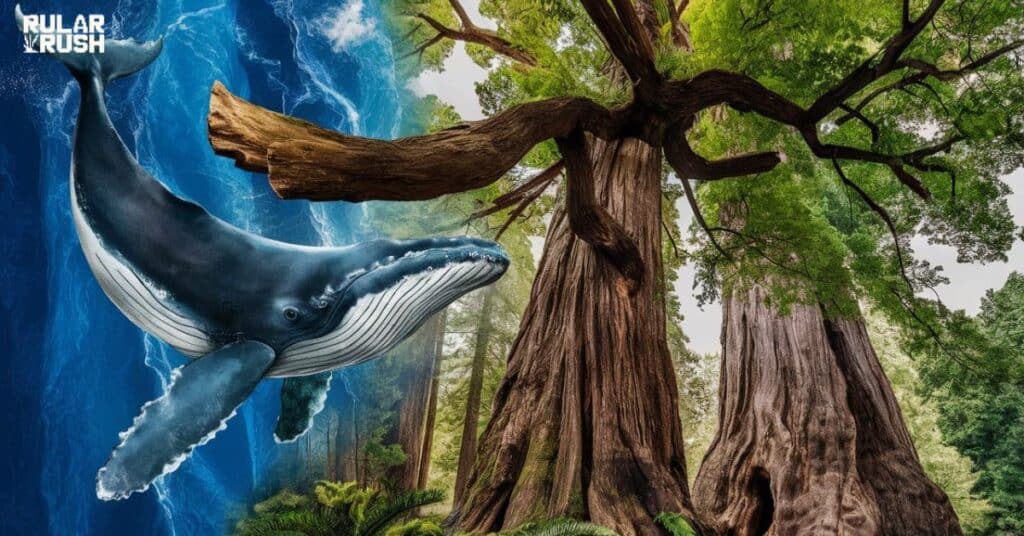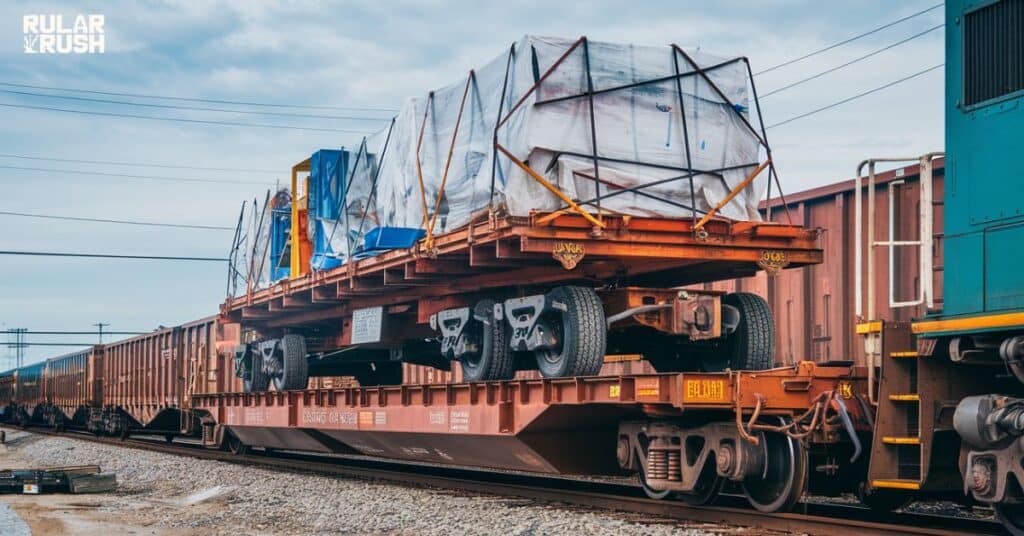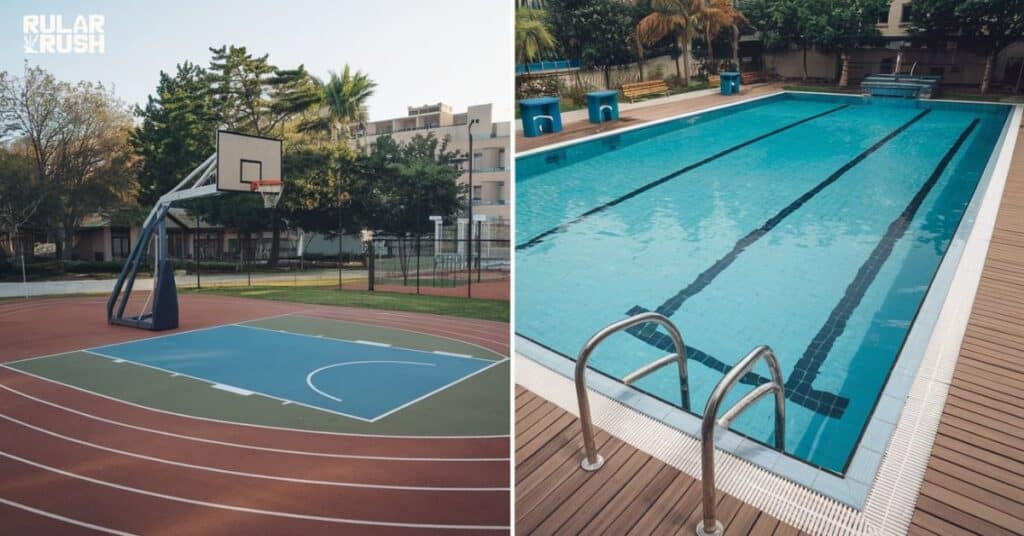
Have you ever stopped to ponder just how long 100 feet is? It’s a measurement we encounter frequently in our daily lives, yet visualizing it can often be a challenge. In this comprehensive exploration, we’ll delve into 10 things that are 100 feet long and uncover some surprising comparisons that will forever change the way you perceive this distance.
From nature’s grandest wonders to incredible human-made feats, we’ll take a journey where 100 feet becomes the star of the show. So, get ready as we explore the question: “How far is 100 feet?” in a way that will spark your imagination and help you better understand its size.
How Long is 100 Feet? A Quirky Perspective
Ever wondered how long 100 feet really is? Let’s put this length into perspective with some unexpected comparisons!
The Breakfast Lineup
Imagine lining up 200 boxes of cereal end-to-end. That’s roughly 100 feet! Or picture 50 golden retrievers standing nose to tail – that’s another way to visualize this distance.
The Burrito Benchmark
Here’s a fun fact: 100 feet is about the length of the world’s largest burrito, made in 2018. Talk about a mouthful!
Everyday Objects, Extraordinary Numbers
But wait, there’s more! Check out this quirky comparison table:
| 100 Feet Equals | Approximate Number |
|---|---|
| Banana peels | 300 |
| Rubber ducks | 400 |
| Guitar strings | 600 |
| Paper clips | 1,200 |
| Grains of rice | 300,000 |
The Sneeze Distance
Ever thought about how many times you’d have to sneeze to travel 100 feet? At an average sneeze speed of 100 mph, it would take about 14 sneezes to propel you that far (don’t try this at home!).
Wildlife Wonders
In the animal kingdom, 100 feet is equivalent to about 33 leaps of a kangaroo or the width of a small pod of dolphins swimming side by side.
The DIY Dimension
For the DIY enthusiasts, 100 feet is approximately the amount of duct tape you’d need to cover an average-sized refrigerator entirely. Now that’s a sticky situation!
So, next time someone asks you “How long is 100 feet?”, you can wow them with these whimsical comparisons. It’s not just a measurement – it’s a journey through the quirky and unexpected!
Understanding 100 Feet: Conversions and Comparisons
Before we jump into our list of things that are 100 feet long, let’s first go over some important conversions. After all, 100 feet isn’t just one measurement—it connects to different systems and can be understood in various ways.(how long is 100 feet)
Metric Equivalents
For those more comfortable with the metric system, here’s what you need to know about converting feet to meters:
- 100 feet in meters: 30.48 meters
- 100 feet in kilometers: 0.03048 kilometers
To put this in perspective, if you were to walk 100 feet, you’d cover just over 30 meters – about the length of a short bowling lane or three-quarters of an Olympic-sized swimming pool lane!
Imperial Measurements
For those who prefer imperial units, here’s how 100 feet breaks down:
- 100 feet in inches: 1,200 inches
- 100 feet on a football field: 27.8% of the length (an American football field is 360 feet long)
Imagine lining up 100 rulers end-to-end – that’s the length comparison we’re talking about for 100 feet! It’s also equal to the height of a 10-story building or the length of two standard school buses parked end to end.
Now that we’ve got the measurements clear, let’s dive into some interesting examples of things that are 100 feet long.
Nature’s Giants: Living Things That Reach 100 Feet

The Blue Whale: Ocean’s Colossal Inhabitant
When we think of things that are 100 feet long, the blue whale is a perfect example. As the largest animal ever to exist on Earth, a blue whale can grow up to 100 feet, though most average around 80-85 feet.
Fun Fact: A blue whale’s tongue alone can weigh as much as an elephant – about 5,400 pounds!
Let’s dive deeper into the blue whale’s impressive stats:
| Blue Whale Stat | Measurement |
|---|---|
| Maximum Length | 100 feet |
| Average Length | 80-85 feet |
| Maximum Weight | 200 tons |
| Heart Weight | 400 pounds |
| Tongue Weight | 5,400 pounds |
| Aorta Diameter | 9 inches |
Compared to other marine life, the blue whale dwarfs its ocean companions. Here’s a quick comparison:
- Great White Shark: 15-20 feet
- Killer Whale (Orca): 20-26 feet
- Humpback Whale: 48-62 feet
- Sperm Whale: 49-59 feet
- Blue Whale: Up to 100 feet
The blue whale’s enormous size allows it to hold some impressive records:
- Loudest animal on Earth: Its calls can reach 188 decibels, louder than a jet engine
- Largest heart of any animal: About the size of a small car
- Biggest baby in the animal kingdom: A newborn blue whale calf is about 23 feet long and weighs up to 3 tons
Towering Trees
While not animals, some trees can easily reach or even surpass the 100-foot mark. Here are a few examples of these arboreal giants:
- Coast Redwood: These giants can grow over 300 feet tall!
- Giant Sequoia: While not as tall as redwoods, they’re more massive and regularly reach 100 feet.
- Douglas Fir: Common in the Pacific Northwest, mature trees often exceed 100 feet.
- Eucalyptus regnans: Native to Australia, these trees can grow up to 330 feet tall.
- Sitka Spruce: Found along the Pacific Northwest coast, they can reach heights of 300 feet.
Interesting Tidbit: A coast redwood named Hyperion holds the record for the world’s tallest tree at 380.1 feet – that’s nearly four times our 100-foot measure!
The age and growth rate of these trees are equally fascinating:
- Coast Redwoods can live over 2,000 years
- Giant Sequoias can live for 3,000 years or more
- Douglas Firs typically live 500-1,000 years
- Eucalyptus regnans can live up to 400 years
- Sitka Spruce can live for 700 years or more
Imagine standing next to a living thing that’s been around since the Roman Empire – and it’s 100 feet tall! These trees are not just impressive in size, but they also play crucial roles in their ecosystems:
- They provide habitats for countless species of birds, insects, and small mammals
- Their extensive root systems help prevent soil erosion
- They act as carbon sinks, helping to mitigate climate change
- Some, like the redwoods, create their own ecosystems in their canopies
Marvels made by man: Structures and Vehicles at 100 Feet

The 10-Story Building
A 10-story building is often cited as an example of something that’s about 100 feet tall. But why is this the case, and how does it vary?
Average height per story:
- Residential buildings: 10-12 feet per floor
- Commercial buildings: 12-15 feet per floor
So, a 10-story residential building could be anywhere from 100-120 feet, while a commercial one might reach 120-150 feet.
Building design variations:
- Some buildings have higher ceilings on the ground floor for grand entrances or retail spaces
- Penthouses often have higher ceilings for a more luxurious feel
- Mechanical floors for elevators and HVAC systems can add height without being counted as a “story”
“Architecture is the learned game, correct and magnificent, of forms assembled in the light.” – Le Corbusier
This quote reminds us that buildings are more than just their height – they’re complex structures designed for human use and aesthetic appeal. A 100-foot tall building represents a significant engineering achievement, balancing factors such as:
- Structural integrity
- Wind resistance
- Earthquake safety
- Efficient use of space
- Energy efficiency
- Aesthetic appeal
Aircraft Dimensions
When we think about things that are 100 feet long, certain aircraft come to mind. The Boeing 737-500, for instance, measures 101 feet in length.
Boeing 737-500 Specs:
- Length: 101 feet 9 inches (31.0 m)
- Wingspan: 94 feet 9 inches (28.9 m)
- Height: 36 feet 6 inches (11.1 m)
- Maximum takeoff weight: 133,500 lbs (60,555 kg)
- Cruising speed: 530 mph (853 km/h)
Aircraft length affects performance in several ways:
- Passenger capacity: Longer planes can carry more passengers
- Fuel efficiency: Length impacts aerodynamics and fuel consumption
- Maneuverability: Shorter planes are often more agile
- Airport compatibility: Some airports have length restrictions on their runways
The Boeing 737-500 is just one example of an aircraft around 100 feet long. Here are a few others for comparison:
- Airbus A318: 103 feet 2 inches
- Embraer E175: 103 feet 11 inches
- Bombardier CRJ900: 118 feet 11 inches
Each of these aircraft has been designed to balance factors like passenger capacity, range, and airport compatibility. The fact that many fall close to the 100-foot mark is a testament to the sweet spot this length represents in aviation design.
Transportation and 100 Feet

Railroad Cars in Tandem
Two standard railroad cars placed end-to-end often measure close to 100 feet. Let’s break it down:
Standard lengths of different car types:
- Box car: 50-60 feet
- Flatcar: 60-89 feet
- Tank car: 55-65 feet
- Passenger car: 65-85 feet
- Autorack car: 89 feet
Two 50-foot box cars would give us our 100-foot length almost exactly!
Impact on rail transport efficiency:
- Longer cars can carry more cargo, reducing the number of cars needed
- However, longer cars may have turning radius limitations
- Some routes have length restrictions due to tunnels or other infrastructure
- Longer trains can be more fuel-efficient per ton of cargo
The use of standardized car lengths around 50 feet has several advantages:
- Interchangeability between different rail lines and companies
- Easier scheduling and capacity planning
- Simplified loading and unloading processes
Semi-Trailers: The Backbone of Trucking
Two semi-trailers placed end-to-end often measure close to 100 feet. Here’s why:
Typical trailer lengths and regulations:
- Standard semi-trailer: 48-53 feet
- Maximum allowed length (US highways): 53 feet
- Some specialized trailers can be up to 57 feet long
So, two 50-foot trailers would give us our 100-foot measurement.
Maneuvering challenges for drivers:
- Longer trailers require more skill to back up
- Turning radius increases with trailer length
- Some urban areas have length restrictions
- Wind resistance increases with trailer length, affecting fuel efficiency
“Truck driving is not just a job, it’s a lifestyle.” – Anonymous Trucker
This quote reminds us of the skill and dedication required to handle these massive vehicles day in and day out. A 100-foot length in trucking represents:
- A significant amount of cargo capacity
- A balance between efficiency and maneuverability
- The result of decades of industry standardization
- A testament to the skill of truck drivers who navigate these large vehicles
Sports and Recreation: 100 Feet in Play

Basketball Court Dimensions
A regulation NBA basketball court is 94 feet long, just shy of our 100-foot mark. This length has a significant impact on the game and player performance.
NBA court specifications:
- Length: 94 feet
- Width: 50 feet
- Three-point line distance: 23 feet 9 inches (from center of basket)
- Free throw line: 15 feet from the backboard
How court size influences gameplay:
- Affects player stamina (more running)
- Impacts defensive strategies (more space to cover)
- Influences fast break opportunities
- Determines positioning for various plays
The 94-foot length of a basketball court is carefully chosen to:
- Provide enough space for strategic play
- Ensure the game is fast-paced and exciting
- Allow for a variety of offensive and defensive tactics
- Fit within standard indoor arena dimensions
Swimming Pools
While an Olympic-size swimming pool is longer than 100 feet (164 feet or 50 meters), many competitive pools come close to our 100-foot measure.
Swimming pool lengths:
- Olympic pool: 164 feet (50 meters)
- Short course pool: 82 feet (25 meters)
- Many public pools: 75-100 feet
Training implications:
- Swimmers in 100-foot pools do more turns than in Olympic pools
- More turns can help improve push-off technique
- Shorter pools allow for more precise timing of laps
- Different pool lengths can affect race strategies
The choice of pool length can significantly impact swimming performance:
- Longer pools favor swimmers with better endurance
- Shorter pools can lead to faster times due to more push-offs
- Training in various pool lengths can help swimmers adapt to different conditions
Urban Landmarks and 100 Feet

The Hollywood Sign: A Scale Comparison
The iconic Hollywood Sign provides an interesting comparison to our 100-foot measure.
Hollywood Sign specs:
- Each letter is about 45 feet tall
- Total length of the sign: 352 feet
- Two letters of the sign would be about 90 feet tall
- The letters are 5 feet deep
- The sign weighs 450,000 pounds in total
Visual impact from different distances:
- Visible from 15 miles away on a clear day
- Best viewed from about 7 miles away for full effect
- From 100 feet away, a single letter would tower over the viewer
The Hollywood Sign, at over three times our 100-foot measure, serves as a reminder of how impressive structures of this scale can be. It’s not just a sign, but a landmark that:
- Represents the entire film industry
- Serves as a tourist attraction
- Has become a symbol of Los Angeles and American culture
- Demonstrates the impact of large-scale typography in landscape design
City Block Lengths
City block lengths vary widely, but many are close to our 100-foot measure. Understanding these variations gives us insight into urban planning and city life.
Variation in block sizes across cities:
- New York City: Typically 264 feet by 900 feet
- Portland, Oregon: 200 feet by 200 feet
- Salt Lake City: 660 feet by 660 feet
- Chicago: 330 feet by 660 feet
- San Francisco: Varies, but many are around 412.5 feet by 275 feet
How 100 feet relates to urban planning:
- Walkability: Shorter blocks (closer to 100 feet) are often more pedestrian-friendly
- Traffic flow: Longer blocks can improve vehicle flow but may reduce pedestrian access
- Mixed-use development: 100-foot blocks can provide a good balance for various urban uses
- Public spaces: Block size influences the placement and size of parks and plazas
The choice of block size in urban planning has far-reaching effects:
- It influences the character and feel of a neighborhood
- It affects property values and development potential
- It impacts the efficiency of public transportation systems
- It can contribute to or mitigate urban heat island effects
Everyday Objects: Visualizing 100 Feet

Dining Tables in Series
Imagining a series of dining tables can help visualize 100 feet in a relatable way.
Average table lengths and seating capacity:
- 6-person table: 6 feet
- 8-person table: 8 feet
- 10-person table: 10 feet
- 12-person table: 12 feet
So, ten 10-person dining tables lined up would give us our 100-foot length!
Imagining a 100-foot dinner party:
- Could seat approximately 100 people
- Would require about 25 tablecloths
- Passing the salt could be quite a challenge!
- Would need about 200 place settings
- Might require a team of 10-15 waitstaff to serve efficiently
This visualization helps us understand 100 feet in terms of social gatherings and hospitality spaces. It also provides insight into:
- Restaurant design and capacity planning
- Event planning for large gatherings
- The logistics of catering and food service
- The importance of acoustics in large dining spaces
Luxury Cars: Rolls-Royce Phantoms
Five Rolls-Royce Phantoms parked bumper-to-bumper would measure close to 100 feet, offering a luxurious way to visualize this length.
Rolls-Royce Phantom specs:
- Length: 19 feet 5 inches
- Width: 6 feet 7 inches
- Height: 5 feet 4 inches
- Wheelbase: 11 feet 10 inches
- Curb weight: 5,644 lbs (2,560 kg)
The extravagance of five in a row:
- Total value: Approximately $2.5 million
- Combined weight: About 12.5 tons
- Total horsepower: Around 2,270 HP
- Combined fuel tank capacity: 475 liters
- Total leather used in interiors: Enough to cover a tennis court
This comparison not only helps us visualize 100 feet but also provides a glimpse into the world of luxury automobiles. It highlights:
- The scale of high-end automotive engineering
- The balance between size and luxury in car design
- The economic impact of luxury goods
- The craftsmanship involved in creating these vehicles
Infrastructure and 100 Feet

Highway Lane Widths
While a single lane isn’t 100 feet wide, understanding lane width helps us visualize 100 feet in a new way.
Standard lane dimensions:
- Interstate highway lane: 12 feet wide
- Local road lane: 9-11 feet wide
So, about 8 interstate highway lanes laid side by side would equal 100 feet!
Safety considerations in road design:
- Wider lanes can improve safety at higher speeds
- Narrower lanes can help calm traffic in urban areas
- Shoulder width also plays a crucial role in highway safety
Bridge Spans
Many bridge spans are close to or exceed 100 feet, making them a great way to visualize this length.
Examples of 100-foot bridge sections:
- Many highway overpasses
- Pedestrian bridges in parks or campuses
- Small river crossings
Engineering challenges at this scale:
- Material selection: Steel, concrete, or a combination
- Load-bearing capacity: Must support its own weight plus traffic
- Environmental factors: Wind, temperature changes, and seismic activity
- Maintenance: Ensuring longevity and safety over decades of use
Conclusion
As we’ve journeyed through this exploration of things that are 100 feet long, we’ve seen how this measurement appears in nature, in our cities, and in the objects we use every day. From the majestic blue whale to the practical semi-trailer, 100 feet is a length that bridges the gap between the everyday and the extraordinary.
Whether you’re visualizing the length of a basketball court, imagining a line of luxury cars, or considering the height of a 10-story building, you now have a rich tapestry of comparisons to draw upon when you hear the phrase “100 feet.”
Interactive Element: “Measure Your World”
Now that you’re a pro at visualizing 100 feet, why not take this knowledge into the world? Here are some suggestions for finding 100-foot lengths in your environment:
- Pace out 100 feet in a park or open area (remember, an average pace is about 2.5 feet)
- Look for buildings or structures that might be close to 100 feet tall or long
- Try to estimate 100 feet while driving (but keep your eyes on the road!)
- Use a measuring app on your smartphone to check your estimates
We’d love to see what you discover! Share your 100-foot findings on social media with the hashtag #100FeetChallenge. Who knows? You might just start seeing the world in a whole new way – 100 feet at a time!

Elizabeth is an experienced blogger at “Rular Rush,” specializing in delivering precise and insightful content on various measurement topics. With a passion for simplifying complex concepts, she brings clarity and depth to each post, making technical information easy to understand for readers worldwide.






